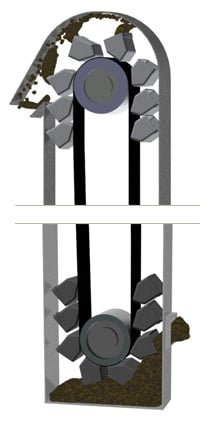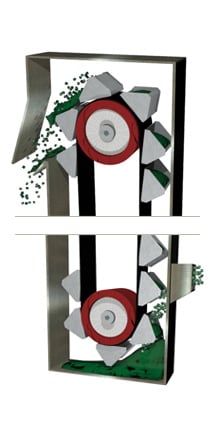When selecting a bucket elevator, the goal is to allow for the most efficient process flow possible. Two elevator designs are available: centrifugal and continuous. Both styles are designed to move material vertically, with each offering distinct advantages.
Centrifugal Bucket Elevators
The centrifugal style elevator has the ability to move large amounts of material quickly, and works well for durable and abrasive materials like sand, gravel, and other free-flowing bulk solids.
The centrifugal style elevator starts by scooping material from the boot or inlet section; this action requires a durable bucket (see Bucket Style Selection for more information). Due to the high speed of operation, this elevator generates centrifugal force at the head pulley. This force throws the material out of the bucket and into the discharge chute as shown in figure 1. The launching and digging actions of this design run the risk of damaging fragile material, so this style is not recommended when handling more delicate materials.
Centrifugal style elevators are available in either belt or chain drive. The elevator shown in figure 1 is setup with AC style buckets mounted on a belt drive system. Due to belt stretch and chain strength, both systems have some restrictions when they reach immense heights. FEECO can assist in fine-tuning the technical details to ensure efficiency for the specific requirements.
Continuous Bucket Elevators
Conversely, the continuous elevator is designed to operate at a slower speed to eliminate the throwing action, and is therefore better suited for gentle material handling.
With a continuous style elevator, buckets are specifically designed to act as part of the discharge chute when inverted as shown in figure 2.
The material pours out of the bucket and slides down the preceding inverted bucket into the discharge chute. Even though the buckets will scoop up some material from the boot, this elevator is designed with a higher feed inlet to allow the majority of material to flow directly into the buckets. This design greatly reduces the damage and degradation of more fragile and friable materials. Additionally, this functionality is beneficial when the product is light and/or fluffy and needs to avoid aeration. The elevator design depicted in figure 2 is setup with the medium front bucket style mounted on a belt drive system.
FEECO has over 70 years of experience in the engineering, designing, and manufacturing of bucket elevators. Where most elevator manufacturers rely on modular designs, at FEECO, we understand that each material has specific requirements. In many cases, a custom solution is the key to an innovative and efficient bucket elevator. Collaborating with our customers, as well as our in-house experts (R&D, engineering, and design), we can create the best possible result to suit the customer’s unique handling system needs.
For more information, contact us today.




